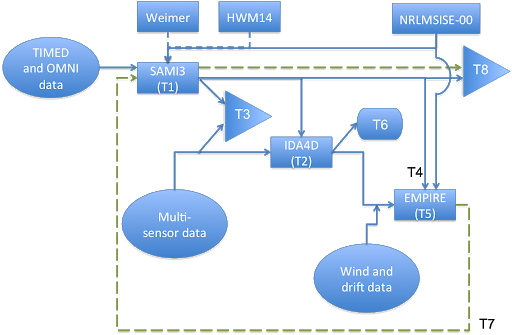A nighttime ionospheric localized enhancement (NILE) at mid-latitudes during extreme storms
Who Will Do What:
-
NRL will set up and run SAMI3: Download TIMED EUV and OMNI solar wind; Launch and monitor SAMI3 runs (up to 20 runs/yr possible); QC outputs; additional simulations with different high-lat potential models or products as appropriate.
-
JHUAPL will run IDA4D with SAMI3 as background model: download all data sets not already obtained from prior investigations; QC data sets; prepare data for input to IDA4D; launch&monitor IDA runs; QC outputs.
-
All: Compare/contrast SAMI3 outputs with measurements: identify whether forcing effects saturate to contribute to model errors; classify storm data by severity, availability by sector/LT.
-
Illinois Tech will adapt EMPIRE to: ingest plasma drifts/field data; use SAMI3 outputs as background densities and electric fields.
-
Illinois Tech will run EMPIRE with SAMI3, HWM as background and IDA4D, drifts, fields, winds as input data: download data sets; QC data; prepare data for input; launch&monitor EMPIRE; QC outputs.
-
All: Analyze IDA outputs to conclude whether storm severity correlates with features of the NILE.
-
Illinois Tech/NRL: Feed EMPIRE outputs back to SAMI3: prepare EMPIRE outputs for SAMI3, interpolating as needed; run SAMI3 using E fields and winds output from EMPIRE; switch these drivers on/off to understand their relative significance to the NILE.
-
All: analyze EMPIRE and SAMI3 adjustment to low-latitude winds and fields: are they consistent with hypothesized super-fountain, disturbance wind dynamo? Are they sector-specific?
Subset groups can collaborate on individual org tasks, as appropriate.
What Are Our Expectations:
PI will represent in FST telecons, and others will always be welcome.
To check in with each other monthly for ironing out dependencies, providing inputs/outputs, coordinating run parameters as needed, and analysis.
To aim to provide SAMI3 runs to FST in year 2, IDA4D runs in year 3, and EMPIRE runs in year 4.
What Are Our Objectives:
To establish fundamental properties of the nighttime ionospheric localized enhancement (NILE),
address whether the phenomenon only occurs during extreme storms,
and test causal hypotheses.
What Are Our Goals:
Using physics-based models, observational data, and data assimilation, to determine:
-
where and when have NILEs occurred;
-
whether properties of the NILE correlate with the severity of the storm;
-
the plasma source of the NILE and ionosphere-thermosphere dynamics causing it.
What Are Our Milestones:
Year 1: Produce SAMI3 simulations of storms and compare to observations during the storms.
Year 2: Infer additional properties of the NILE feature assimilating the relevant data with SAMI3 into IDA4D
Year 3: Estimate wind and electric field drivers based on direct observational data and plasma rates output by IDA4D with EMPIRE.
Year 4: Feed the stormtime adjusted winds and electric potential from EMPIRE output back into SAMI3
COIs
-
Naval Research Lab (McDonald): Physics modeling of storm-time ionospheric dynamics.
-
JHUAPL (Bust, Chartier): Data preparation and assimilation for estimation of time-varying plasma density.
-
Illinois Tech (Datta-Barua): Data assimilation for estimation of electric fields and neutral winds.




